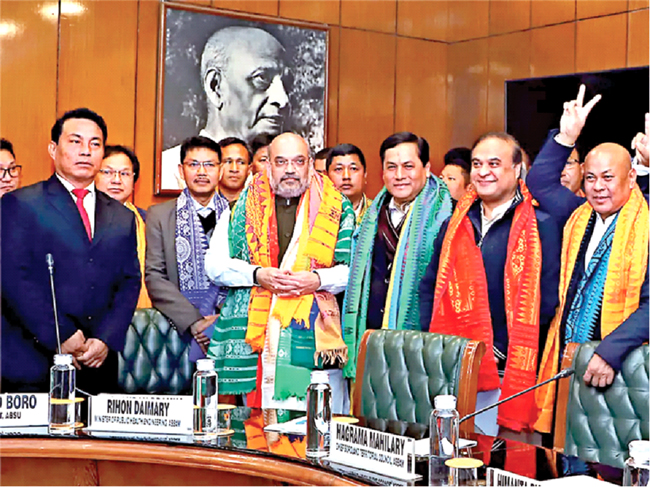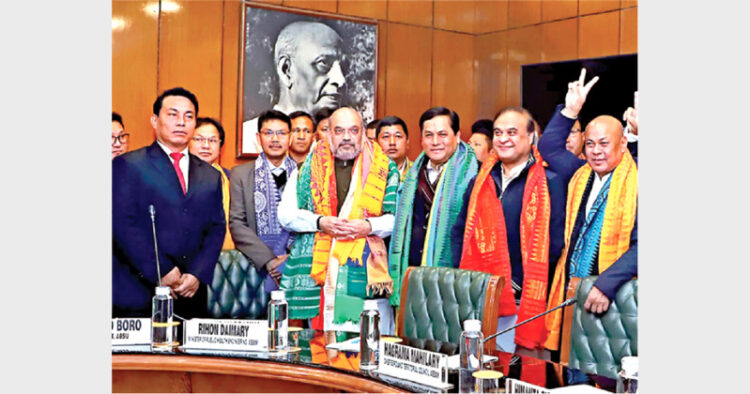
Union Home Minister Amit Shah during the signing of a historic agreement between Government of India, Government of Assam and Bodo representatives to end the over 50-year old
Bodo crisis in New Delhi on January 27, 2020
Bodo crisis in New Delhi on January 27, 2020
North-East is an important symbol of Bharatiya culture, where diversity is celebrated with inherent unity. Disconnect not just because of geographical distance but also due to apathy of Delhi infested the potential Ashta-Laxmi with a culture of Guns. When people like Sharjeel are dreaming about cutting the North-Eastern States from rest of Bharat, Modi-led NDA Government is transforming this Gun-Culture to the culture of mutual Gains by addressing the concerns of locals and providing them with the opportunities through real development
Shrutikar Abhijit
North-Eastern Region occupies around eight per cent of India’s total landmass and houses around four per cent of the nation’s total population and has the potential to contribute immensely in a holistic manner to India’s GDP. It also has a hydropower potential of nearly 50,000 Mega Watt, mostly untapped, and has natural gas reserves of 190 billion cubic metres, coal reserves of 900 million tons, Oil reserves of almost 500 million tonnes and is also a Gateway to the South-East Asian markets. Realising its potential, the Central Government is investing hundreds of crore into infrastructure projects securing connectivity from North-East via Moreh border to Myanmar and other South-East Asian markets.
While South-East Asia is a promising market for high-speed diesel, textiles, wheat flour, fertilisers etc. from India. India, at the same time, is a significant destination market for electronic goods, gems, tropical fruits along with medical tourism from South East Asia.
A significant portion of the trade across the Moreh border is informal. Yet the formal inbound trade from Myanmar to India across the Moreh-Tamu border has seen a growth from US$ 11.28 million in 2005-06 to US$ 177.20 million in 2018-19, and Indian exports to Myanmar through Moreh has registered an increase from US$ 4 million in 2005-06 to US$ 23.45 million in 2018-19.
Furthermore, passenger movement along the Moreh-Tamu border since August 2018 is considerably rising and monthly passenger movement across the Moreh has recorded a rise from 200 persons in August 2018 to 910 persons until August 2019. Imphal alone had received around 1000 medial tourists within a month of resuming passenger moment across the border. By ending the insurgency problem and warranting lasting peace and stability in North-East, accompanied by a boost in rail and road infrastructures, the North-eastern region will witness a significant rise in the number of inbound pilgrims from these predominantly Buddhist countries. It has the potential to grow as a stopover for tourists and pilgrims from these countries, and of generating opportunities for employment. Analysts believe that bringing peace to North-East is of utmost importance if India wants to realise the $5-trillion economy goal by 2024. Apart from its impact on the economic front, ensuring peace in the North-East is of enormous importance to fulfil its strategic needs.
Strategic Impact
Due to years of apathy by previous governments, the situation in the North-East had soared severely. The fear of angering China resulted in an artificially induced slow growth of strategic infrastructures across the region. The examples of stalling strategically significant projects like the Bogibeel Rail-Road project and Dhola-Sadiya Road bridge project are a standing testimony of the claim. The hazardous propensities displayed by the Congress governments in developing such projects seemed like a benchmark of their coaxed attitude of resolving the insurgency problem in the North-East. To give an insight as to how the ignorant handling of these matters had impacted the national interests, I am briefing my readers about the example of ULFA, one of the first insurgent groups from the North-East. Initially, born as a moment to expel illegal Bangladeshi immigrants, later influenced by foreign agencies, quickly became an insurgent group demanding independence of Assam from India and then ended up being based in Bangladesh. Besides, with changing regimes in Bangladesh and establishment of pro-Pakistani government there, paved the way for India’s arch-enemy, the ISI, to influence the policies of ULFA and other insurgent groups based in Bangladesh.
The ISI believed that if it could increase the tempo of insurgent activities in North-East, India would have no option but to withdraw troops from the Kashmir front and engage its resources and attention in the North-East, thus opening multiple fronts for India. The ULFA chief, Paresh Baruah, acknowledged this strategy of the ISI to Bertil Litner, a renowned Swedish journalist and an authority on the affairs of South East Asia. In April 2004, a large consignment of Arms and Ammunitions containing 2,000 Chinese made automatic and semi-automatic weapons, rocket-propelled grenade launchers etc. originating from China and assisted by Pakistan through a Dubai based Businessmen was seized in the Chittagong port of Bangladesh. The weapons were estimated to be of around $ 4-5 Million and revealed the direct involvement of China and Pakistan in facilitating it. Therefore, it was even more necessary that an amicable solution is tabled and save North-East from the on-going troubles. The limited case study of only one such insurgent group, the ULFA has unveiled the hand of foreign agencies in forcing its hands though these insurgent groups to destabilise the Country. Concomitantly, the North-eastern region had been for decades bloodied by many insurgent groups.
Apart from having the hand of foreign agencies in troubling the N.E., the situation was being conveniently exploited by various over ground variables within India to exploit the fault lines and fulfil their vested interests. Namely, the ‘Troika’ (an alliance of Jehadist-evangelist and Naxals under a minimum common programme) utilised the instability to run their respective agendas and further trouble the region and hamper peace, harmony and prosperity of North East.
The Bru-Reang quadripartite rehabilitation agreement has ended an issue that has been affecting the lives of more than 40,000 of displaced Brus from Mizoram living in various refugees’ camps set across Tripura. What started as a demand for self-administration within the ambit of Indian Constitution degenerated into a full-blown ethnic clash between Bru’s and Mizo’s, and the Minority Bru community had to seek refuge in the neighbouring state of Tripura. The Bodo insurgency issue also started on more or Less similar lines, and with NDA government Bodoland territorial council to Bodoland Territorial Region, all insurgent fractions, around 1,500 cadres had laid down their arms and joined the mainstream.
Likewise, by concluding the Naga Accord and pursuing RK Meghan, the Manipur separatist leader (UNLF Chief) currently in NIA custody, and tailgated by a peace deal with ULFA as notified by the NEDA (North-East Democratic Alliance) Convenor, Himanta Bishwa Sarma, will end the remaining feuds hampering the development of North-eastern region.
After completing the peace process and sealing the faith of insurgency followed by strong developmental measures to generate employment opportunities, India has to delegate its focus on the internal threats posed by the ‘Troika’. However, once our misled brethren join the mainstream, it won’t be a hard task to rid North East of the Troika and its Proxies.
(The writer is a Fellow with “Institute for Conflict Research and Resolution” a think tank that specialises in monitoring Conflicts, Defence, Security, Diplomacy and Socio-Political issues. The writer, has comprehensive experience in monitoring issues related to North East)













Comments